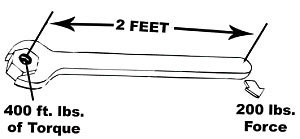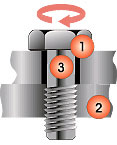 |
|
According to Webster:
|
Basic Torque Formula
L (length) x F (force) = T (torque)

Example: A two foot lever at a right angle to the fastener with 200 pounds at the end will produce
400 foot/pounds of torque.
Torque Formula: L x F = T
|
|
|
What are we trying to achieve with a torque wrench?
Answer: Proper Clamping Force |
|
 |
Torque and Clamping Force
Controlling
the torque applied in tightening threaded fasteners is the most
commonly used method for the application of clamping force. There are
many factors which may affect the relationship between torque and
clamping force of threaded fasteners. Some of these are: the type of
lubricant used on the threads, the material from which the bolt and nut
are made, the type of washers used, the class and finish of threads and
various other factors. It is not possible to establish a definite
relationship between torque and clamping force which will be applicable
for all conditions.
Torque Versus Clamping Force
Only a small part of the torque applied to a fastener contributes to
clamping force. The remaining, as much as 90% of the total applied
torque, is used to overcome friction under the fastener head (or
between nut and washer) and friction in thread engagement.
TORQUE
Head Friction:
45% - 55%
Thread Friction:
35% - 45%
Clamping Force:
10%
|
TORQUE 1. Head Friction
1. Head Friction
2. Thread Friction
3. Clamping Force

|
|
|
|
 |


